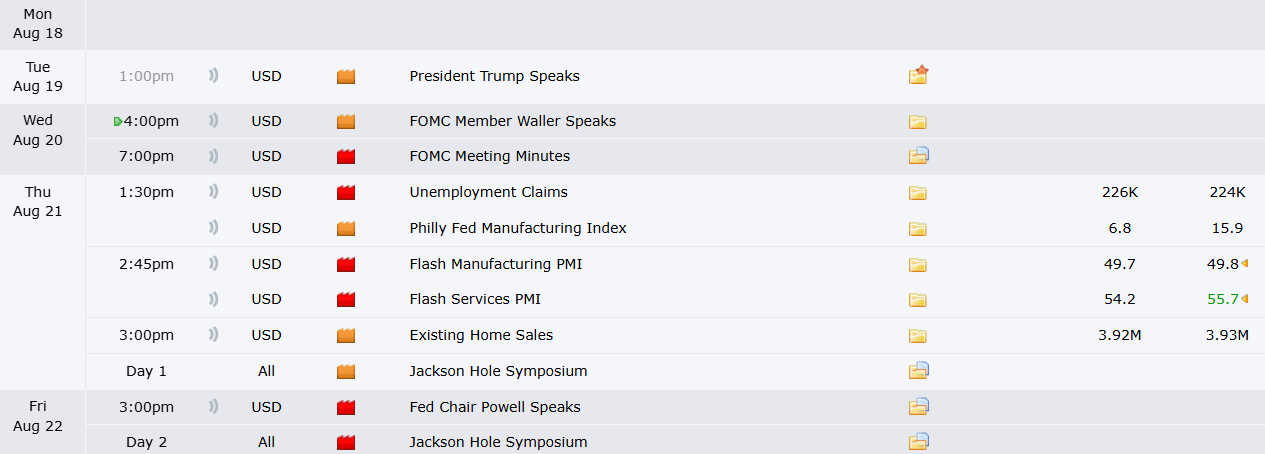TLDR
- Bitcoin drops below $114,000 and Ethereum falls 5.3% as crypto market cap loses $107 billion to $3.77 trillion
- Federal Reserve FOMC minutes release today and Powell’s Jackson Hole speech Friday could impact September rate cuts
- Crypto-related stocks underperform broader markets with mining companies and exchanges down 5-7%
- Eight economic factors including tariff pressures and sticky inflation suggest Fed may delay rate cuts
- Digital assets remain more sensitive to interest rate expectations than traditional equities
Cryptocurrency markets faced heavy selling pressure Tuesday as digital asset prices declined across the board ahead of key Federal Reserve policy events this week. The crypto market downturn reflects growing investor anxiety about potential delays to interest rate cuts.
Bitcoin price dropped 3.2% over 24 hours, falling below the crucial $114,000 support level to trade at $113,461. Ethereum experienced steeper losses, declining 5.3% to under $4,200 during the same period.

The cryptocurrency market capitalization fell by $107 billion to $3.77 trillion, representing a broad-based selloff across most digital assets. Alternative cryptocurrencies fared worse, with XRP tumbling 6.2% and Cardano’s ADA sliding 8%.
Crypto-related stocks posted even larger declines than underlying digital currencies. Bitcoin mining company Marathon Digital (MARA) closed down 5.7%, cryptocurrency exchange Coinbase (COIN) fell 5.8%, and business intelligence firm MicroStrategy (MSTR) dropped 7.4%.
Traditional stock markets showed better resilience by comparison. The Dow Jones Industrial Average ended flat, while the S&P 500 fell just 0.59% and the Nasdaq Composite declined approximately 1.5%. This performance gap highlights how cryptocurrency investments remain more vulnerable to shifting interest rate expectations.
Federal Reserve Policy Events Drive Market Uncertainty
Two major Federal Reserve events scheduled this week have cryptocurrency traders positioned defensively. The Fed will publish minutes from its July 29-30 Federal Open Market Committee (FOMC) meeting today at 2 p.m. ET, providing insights into policymaker discussions about inflation trends and economic conditions.

Fed Chair Jerome Powell will deliver his highly anticipated keynote address at the Jackson Hole Economic Policy Symposium on Friday at 10 a.m. ET. The annual gathering of central bankers runs from Thursday through Saturday and traditionally serves as a platform for major policy announcements.
These events could shape market expectations heading into the Fed’s September policy meeting. Traders are closely watching for signals about whether the central bank will proceed with interest rate cuts or maintain current monetary policy settings.
Multiple economic factors suggest Federal Reserve officials may adopt a cautious stance toward rate reductions. Companies across various industries have absorbed tariff-related costs to maintain market share, but economic analysts warn this practice cannot continue indefinitely.
Inflation Pressures Complicate Rate Cut Timeline
Recent inflation data continues showing elevated price pressures despite some cooling in certain categories. The Producer Price Index, which tracks wholesale pricing trends, has exceeded forecasts in recent months, indicating persistent inflationary forces throughout the economy.
Corporate executives have begun signaling they will eventually need to pass increased costs from tariffs onto consumers. This potential shift could accelerate consumer price inflation in upcoming months, making a September rate cut appear premature to Fed policymakers.
Current economic indicators present conflicting signals that complicate Federal Reserve decision-making processes. Employment growth has moderated while consumer spending patterns remain relatively strong, creating uncertainty about economic momentum.
Policy complexity around trade tariffs intersects with fiscal policies in ways that are difficult to predict. This uncertainty increases risks of monetary policy mistakes, potentially encouraging Federal Reserve officials to maintain a more cautious approach during the Jackson Hole symposium.
Historical precedent from previous tariff periods also influences Fed thinking. Trade-related cost shocks during 2018-2019 produced delayed but meaningful inflationary impacts, prompting central bank officials to exercise caution during that timeframe.
The July FOMC meeting minutes may reveal internal disagreements among Federal Reserve officials about appropriate policy direction. Hawkish members focused on inflation risks while dovish officials emphasize employment concerns could create tension about next steps.
Fresh economic data releases scheduled this week may influence Powell’s messaging strategy. Thursday brings preliminary August readings on manufacturing and services sector activity, which could reveal building cost pressures related to trade policies.
Cryptocurrency markets face particular challenges from extended higher interest rate periods. Elevated borrowing costs reduce the excess liquidity that typically fuels speculative trading rallies in digital assets and increases operational expenses for crypto mining companies.
Bitcoin currently trades at $113,461 after breaking below the $115,000 technical support level that had provided price stability. The next major support zone sits at $112,526, which has helped maintain Bitcoin’s price floor since early August 2025.
Final Thoughts
Looking at current market conditions, those asking “why is crypto down today” can point to Federal Reserve policy uncertainty as the primary driver behind the $107 billion crypto market decline. With Bitcoin trading below key support at $114,000 and major Fed events scheduled through Friday, digital asset volatility is likely to persist until Powell provides clearer guidance on September rate cut prospects.



